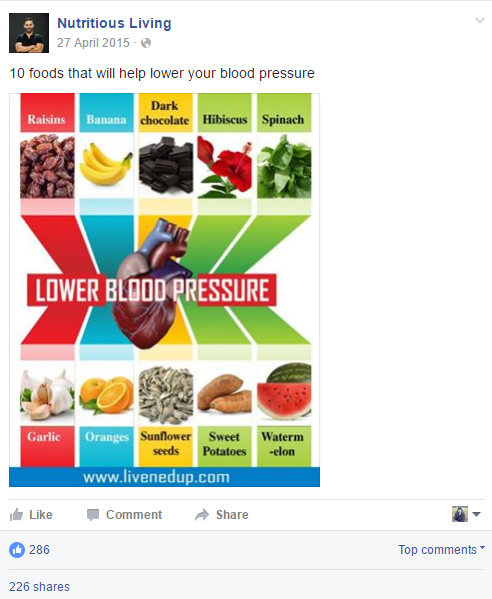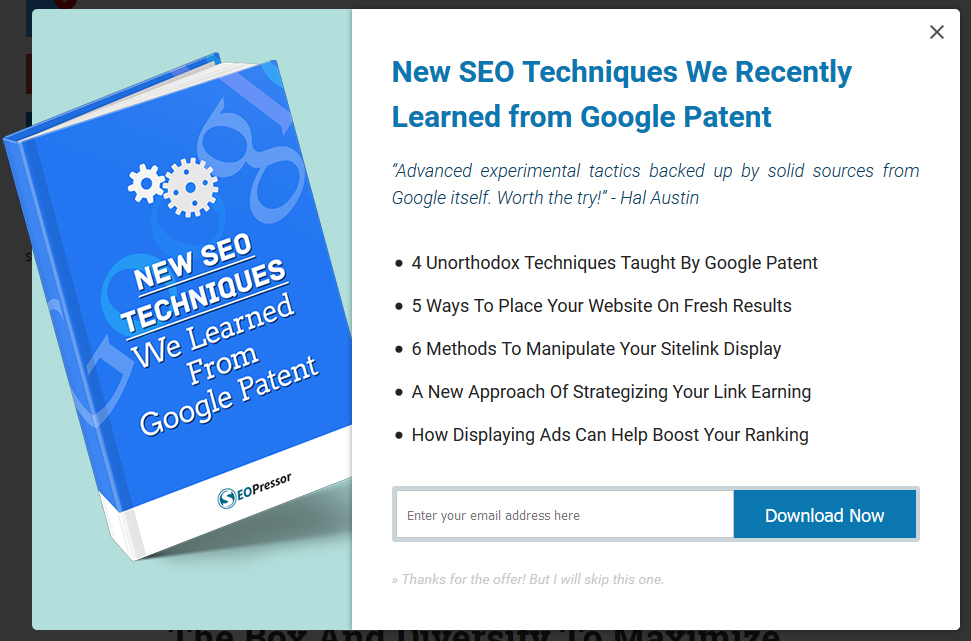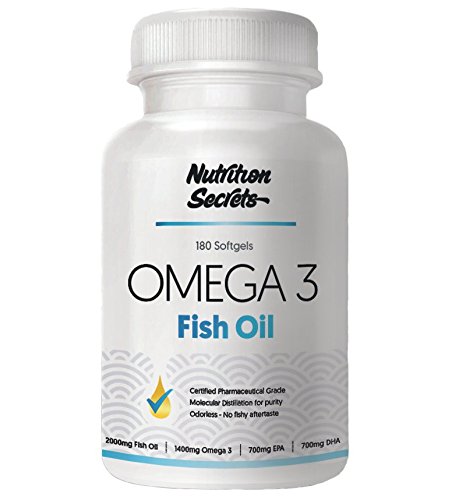Steph W. from SEOPressor


...help you check your website and tell you exactly how to rank higher?


83
score %
SEO Score

Found us from search engine?
We rank high, you can too.
SEOPressor helps you to optimize your on-page SEO for higher & improved search ranking.
By vivian on July 25, 2016

Neil Patel once set himself a challenge: to create a blog that within 12 months would pay him $100,000 a month. That’s 1.2 million dollars a year. From blogging.
It sounded crazy, but he did it.
Even crazier? Anyone can.
[bof_display_offer id=18935]
Theoretically, that is. There’s a huge journey to undertake in order to be able to successfully create that kind of money solely from content.
I’ve pored over every blog post Neil made about his progress, and I’m here to cut through the marketing-minded self-promotion and boil down his progression to the essentials, giving you a roadmap you can follow.
I’ve even dug out for secrets of things Neil did that he didn’t tell others. Another thing I did is to remove as many “Neil Factors” as possible.
“Neil Factors” are the advantages of Neil Patel that might’ve helped his progression. Factors like Neil’s fame or financial capabilities is not something a new beginner might possess.
So I’ve noted them down and offer alternatives or inform you the drawbacks of not having them.
Before then, there are some questions I want you to ask yourself.
Like we’ve talked about before, always start with the why.

Earning money from blog means that I just sit at home and just wait for the cash to pour down, right?
Everybody wants to make money, but when it comes to making money online, so many people believe it’s a matter of getting rich quick, or getting rich easily.
Neither of these are true, at least with this particular method. What this may be able to do, is enable you to get rich passionately.
If you’re already a writer and looking for greater returns on your work, then this is the guide for you.
Similarly, if you already run a blog and want to effectively monetize your content, I will show you how.
This is where the the passion comes in. I’m going to give you four key criteria your topic needs to fulfil. But remember that above all these, you have to be passionate about it.
This topic is going to be something you live and breathe for the next twelve months (most probably more). It will keep you at night, and get you out of bed in the morning.
As such, if you don’t want to be miserable, you have to go with a topic you’re passionate about. But what else?

Your blog should at least be based on your interest, knowledge, the market demand as well as the competition.
Now you know your online writing destiny, I’m going to break down the four key phases in Neil Patel’s journey, so you can replicate it for yourself. This won’t be an exhaustive guide, but it will give you all the direction you should need to make a success of it.
DISCLAIMER: The roadmap below requires elbow grease, entrepreneurial spirit, and independent thought.
The first interesting departure from what many would consider to be common sense is that Neil Patel began his journey not with website building, but with audience building through social media channels like Facebook and Twitter.

Neil’s starts off his journey by building a fanbase to drive traffic and build reputation in the niche.
He focused on finding the very best viral content and sharing them.

Neil spent most of the early days of the challenge building sharing habits of his followers. It can be as easy as sharing simple infographics made by other people.
Whether these were pithy quotes laid over images, genuinely helpful articles written by the people who would later become his competition, or important news related to his niche, he shared a carefully selected collection of high quality content.
Neil became a curator first, not a content producer. This is important, and many people have managed to become financially successful purely through curation – creating a reliable portal that shares the best content.
Some critical points to note during this phase:
Right now, you’re building your audience, developing your status as a trusted source of high quality content, and establishing sharing habits in followers that will be essential to your later success.
Neil created a Facebook page that got 50,000 fans in 30 days. This means a hell of a lot of hustle in not much time, and he already established his name. 38% of his visitors were coming from the blog where he recorded his progress in the challenge, so he stopped hyperlinking.
It may take you longer than 30 days, but 50,000 fans is a great target for you to achieve before moving on to phase two.
Skills Required
Creating a website is no easy task, but it needn’t be difficult either. WordPress together with places like ThemeForest can help people very quickly establish a stunning website that makes it easy to update with great content.
Pro Tip: try to find a website that includes Visual Composer, and you’ll barely have to know any code.

Even though Neil have created the website earlier, he only go full throttle on content writing after getting a sizable amount of followers.
From there, it’s time to start creating your content. The good news is that by curating the fan page for a while, you’ll already have started to understand what works and what doesn’t, what’s performing well and where the current trends are within your niche. All this will be invaluable in helping you nail the content, just make sure it’s both current and high quality.
Neil Patel recruited writers to write for him at this phase. For me, this is the one thing you need to do on your own. While Neil is more than capable of writing, his tight schedule means that he might not able to afford the time to do it. His financial strength on the other hand allows him to outsource them.
As for the most of us, I assume being good at writing is what motivates us to explore this route in the first place.
But, if a content writer writes in a forest and no-one is there to read him, does he make a profit? No.
That’s why it’s time to start understanding Search Engine Optimization (SEO). Facebook and Twitter are great sources of traffic but they’re still no match for the major search engines.
Doing SEO is important in order to get the blog posts you’ll be writing get ranked on relevant searches people type in search engines like Google.
Once this happens, new traffic will passively flow into your blog overtime. Each ranked blog posts will generate a steady stream of traffic, so writing and ranking more blog posts will multiply the amount of people visiting your website.
You can track how much traffic is going to your website by using Google Analytics.
From where your traffic come from (Facebook? Twitter? Google?) to which page on your website is bringing in traffic, all can be tracked from Google Analytics.
Once you have your website built, up and running, you need to get people to start accessing it. This means using your established Facebook page and Twitter feed to ‘seed’ your content amongst all the other stuff you regularly share.
You’ve established your page as a trusted source of expert advice, which means you are essential endorsing yourself by sharing your own content. You immediately put your content in the same playing field as your competition, whose content has helped you develop your audience. This co-opting of authority is the fastest and most efficient route to trust.
You can keep sharing content from other sources, but boost the FB posts that include your content. Slowly you can start phasing out other people’s contents and start exclusively sharing your own content.
It’s also important to optimize your on-page content. This basically means writing your contents revolving around the target keyword you’re trying to rank. This is the least you can do before moving on to the more advanced SEO techniques.
The good news is plugins like SEOPressor Connect allows you to cover on-page SEO without the need for technical knowledge of SEO.
Finally, and this is important, make sure you set up a base to capture visitors’ emails. Having opt-in forms in your website for visitors to subscribe to your mailing list is the main goal for this phase.

Getting visitors to register as subscribers is the main goal of this phase. This can be done by placing opt-in forms and giving away freebies to encourage signups.
This means having your email marketing platform set up. Building your email list can be tough.
It should be, as your email list is practically your potential customer list. Most of the selling and marketing you’ll be doing is going to be done on this group.
It took Neil five months to get his site to 40,870 unique visits per month, 13,431 of which came from search.
Be prepared to take a step back before you take a step forward. SEO takes time, but it pays dividends in the long term. It’s important to remember to tailor content to what people are looking for.
Out of all the traffic, set a conversion rate target of 3-5%. That means out of 1000 visitors, 50 will register as a subscriber.
Having 10,000 visit per month is a good starting target. With 5% conversion rate it means you’ll have around 500 email subscribers in your list.
Later on you can start learning on things you can do to increase your conversion rate.
Skills Required:
Once Neil had a constant stream of traffic and got his list to a sizable amount, he started to look at how he could sell products and services, both digital and physical, that would allow him to cash in on his content.
He quickly identified that selling ad space would never enable him to reach his target. This meant Neil started to look at white-labeling a product, and settled on fish oil to begin with. He discovered fish oil was the right product for his needs, after researching competitive searches for supplements online.

Neil made money off his blog mainly by selling a white-labeled physical product.
He also quickly diversified his revenue funnel by doing affiliate marketing. Doing affiliate marketing means selling other people’s product to your email list and get commission out of it.
It’s easier with platforms such as ClickBank or JVZoo where you can find various product offering affiliate partnership.

Affiliate marketing platforms like ClickBank allow you to find products and services offering affiliate programs. This can help you cash in without needing to have a product of your own.
Most of the process is automated. You just need to come up with the email sales copy telling your subscribers the selling points of the product you’re endorsing. Most affiliates even provide sample title and copy (called swipes) so you can easily build on top of these.
Coming up with multiple branches of monetization is the best practice for maximizing income.
Once Neil had his product decided upon, he used analysis to find the ideal price point, hustled for reviews among his audience, regularly updated the copy on his sales page to discover what approach maximized sales, and improved the label design once he had sold enough initial product to pay for it.
It’s important to note that Neil was thinking about monetization long before his traffic stabilized. This step needs considerable pre-production so that you are ready to pull the trigger once the site is performing well.
Product Types
As long as the product fits the niche, you should be able to use your audience to effectively monetize it.
To get reviews, Neil had to give a lot away. He offered heavy discounts to his existing audience to encourage them to leave reviews, and gave away the free e-book to build that same audience. These were a means to an end, but meant for the first couple of months, Neil didn’t make any money from the product.
They set clear targets for reviews and used their site to action their audience into leaving them. In month one, they aimed for 30 reviews. Month two, 300, month three, 600.
The number identified as the critical mass for when a product begins to sell in significant enough numbers to generate the hallowed $100,000 a month was >1,000 reviews. This should be your target.
Skills Required:
Once the infrastructure around the Facebook page, website and product pages has been created, it’s time to put in the hard yards to increase traffic, get more audience, and improve conversion. Even after all this work, you’ve only created the foundation. Now you have to build on it to reach your target.

By the end of the 12th month, 78% of all traffic to the website comes from search engines, showing the effect of the continuous SEO effort.
By the time Neil had achieved his goal, 78.58% of traffic was coming from search engines. This means the search engine optimization and ad buying. At the peak of their use, the ads cost Neil $9,481. This is when generating income online becomes like running any other business. You have to speculate to accumulate.
Using email marketing platform like Aweber, Neil also tried to maximize his email subscribers, as these were the golden ticket to keeping traffic alive.
Finally, it was down to him to improve conversion from leads to purchasing customers. This included setting up an affiliate program to outsource selling, which worked pretty well, and generating and testing email copy designed to increase conversion.
Neil’s series reporting on his process is an invaluable source of knowledge and resources. It describes how he achieved this epic milestone, and what tools he used to get there. I recommend you check out this round-up, which allows you find the whole series in one easy to navigate post.
Target Checkpoint: This hallowed $100,000 a month.
Skills:
A seasoned, successful, serial online entrepreneur was able to create an audience, fulfil their need for content, and successfully activate that audience for his own ends to turn a profit. He did manage to make $100,000 in one month.
But there were a wide range of expenses. These included the physical product itself (another reason to go digital), hosting, web design, content, accounting, even lawyers to stop people re-selling the products on Amazon.
This halved the income generated, meaning from over $121,000, they made just under $52,000.
Still, that’s $52,000 in a month. Not a bad result, and certainly enough to live comfortably. It’s more than many earn in a year, and it only took twelve months to condense an annual income into a monthly one.
The key take-home from this is that blogging only becomes an effective money making tool if it’s used as a means to an end. The end has to be a product or service of some kind, which means you need to be more than just a writer.
Online courses and e-books will be the closest writers can get to making money from their writing, and there are advantages. Digital copying means there are no overheads on products like there are with supplements. The problem is, the market is much smaller.
All in all, it’s possible. It will almost certainly take you more time. And even then, only if you’re willing to go on a journey that requires huge commitment, personal growth, and a flexible attitude to facing unpredictable challenges.
Now that you know how to make money out of blogs, on the next part of this series, I’ll be talking about the complete skillset you need to learn in order to pull it off effortlessly. So stay tuned!
Read the complete series:
Updated: 10 December 2025


Save thousands of dollars (it’s 100x cheaper)

Zero risk of Google penalty (it’s Google-approved)

Boost your rankings (proven by case studies)
Rank High With This Link Strategy
Precise, Simplified, Fast Internal Linking.
